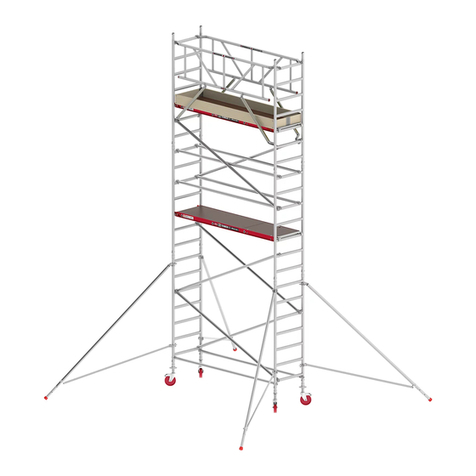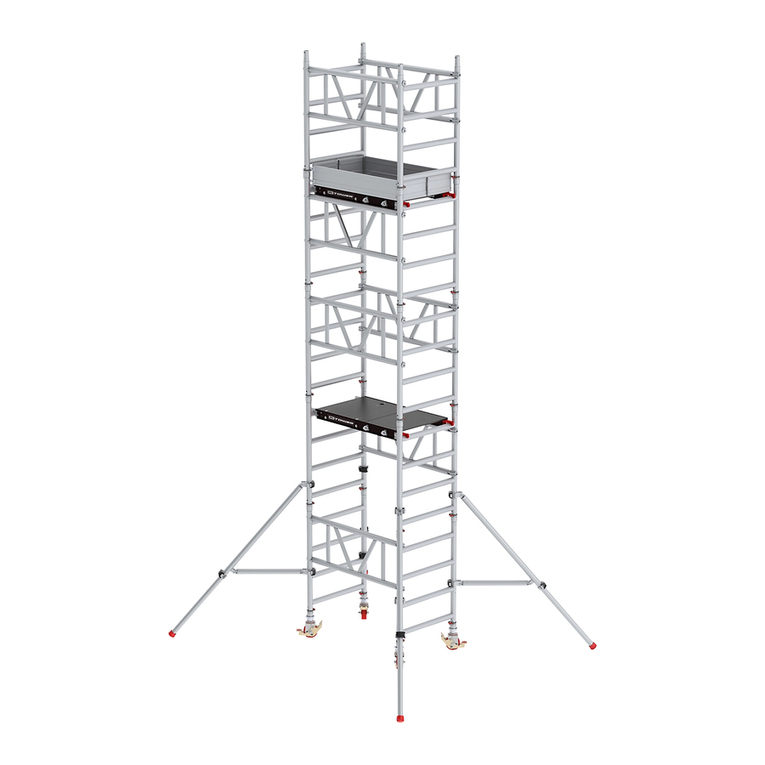
8www.altrex.com
NL
8. Dakophangpunten
- Altrex dakbalken:
- ADB 600 LAAG (WLL 600 kg)
- ADB 600 HOOG (WLL 600 kg)
- ADB 800 LAAG (WLL 800 kg)
- ADB 800 HOOG (WLL 800 kg)
- Dakbalken zijn ontworpen en geclassiceerd voor een bepaalde Work
Load Limit (WLL). Deze WLL geeft aan wat de
maximale capaciteit van de gebruikte takel mag zijn.
- De Altrex dakbalken mogen uitsluitend gebruikt worden op platte daken.
- Controleer de belastbaarheid van de dakconstructie waar de dakbalk geplaatst wordt, voordat de installatie wordt
opgebouwd. Tijdens normaal gebruik, kan de voorbok van de dakbalk een belasting van 1150kg krijgen en de
achterbok van 700kg.
- Om de belasting door het dak te laten dragen kan het nodig zijn om onderlegplaten te gebruiken voor een verdeling
van de belasting.
- Onder extreme omstandigheden zijn deze waarden nog hoger, de belasting op de voorbok kan oplopen tot 3.000kg
- Let op: Het dak moet in staat zijn om de belasting te weerstaan die bij een eventuele extreme omstandigheid zou
kunnen optreden (zoals bij kabelbreuk)!
8.1 Voorbereiding
Bestudeer de conguratie- en belastbaarheidstabellen in bijlagen T5 en T6
- Bepaal welke type dakbalk gebruikt gaat worden.
- Bepaal de lengte van de oversteek: ‘outreach B’
- ADB 600 LAAG / ADB 600 HOOG
- Standaard : 0,9m of 1,2m.
- Met verlengde buitenbalk (415095): 1,6m, 1,9m of 2,2m
- ADB 800 LAAG / ADB 800 HOOG: 0,9m of 1,2m
- Bepaal de afstand tussen de voor- en achterbok: ‘supportdistance A’ die
gewenst is: 4,5m, 5,0m of 5,5m.
- Kijk op de tekstplaat (bijlage T6) bij de takelcapaciteit ‘takel’ die gebruikt
gaat worden. Op de kruising van supportdistance A en de takelcapaciteit
wordt het vereiste aantal contragewichten gevonden (20kg)
- Voorbeeld: Een DAKBALK 400 - 600 HOOG wordt geïnstalleerd,
met een oversteek (‘outreach B’) van 1,2m en een afstand tussen de bokken (‘supportdistance A’) van 5,0m. De
takel heeft een WLL van 600kg. In de belastbaarheidstabel (bijlage T6) kan worden afgelezen dat er 20
contragewichten van 20 kg nodig zijn.
- Bepaal de benodigde lengte van de staalkabels en elektrakabels. Gebruik alleen kabels die voldoen aan de
specicaties van de takelfabrikant. Reken voor de staalkabels minimaal 10 meter extra dan de hoogte van het gebouw.
8.2 Veilig werken op daken
- Indien het dak waarop de dakbalk moet worden geplaatst voldoende veiligheid biedt door middel van een borstwering
of een permanente leuning van minimaal 1m hoogte, hoeft er geen valbeveiliging te worden gebruikt.
- Als er binnen een afstand van 4m vanaf de rand moet worden gewerkt, op een dak dat geen veiligheid biedt door
middel van een borstwering of leuning van voldoende hoogte, geldt het volgende:
- Er mag uitsluitend op het dak gewerkt worden indien men is aangelijnd aan een verankeringspunt op het dak
die geschikt is voor persoonlijke valbeveiliging. Dit geldt tijdens montage, verplaatsen en demontage van de
dakophangconstructie.
- Indien het dak een borstwering van ten minste 10cm hoogte heeft, mag een compleet gemonteerde dakbalk,
waarbij de contragewichten zijn geplaatst en de wielen in de geremde positie staan, worden gebruikt als
verankeringspunt voor persoonlijke valbeveiliging. Men kan daarvoor de verbindingspen achterop de
schokbrekerarm gebruiken. Dit geldt voor bijvoorbeeld het doorvoeren van de ophang- en veiligheidskabel in de
dakbalk die al in positie staat.
- In alle andere gevallen moet een andere manier van valbeveiliging aangebracht worden, b.v. door middel van
randbeveiliging of een verplaatsbaar verankeringspunt.
- Dakbalken mogen alleen worden ge(de)monteerd of verplaatst bij goede weersomstandigheden en bij maximaal
windkracht 6 Beaufort.
- Dakbalken mogen niet worden ge(de)monteerd of verplaatst bij onweer, sneeuw, hagel of ijsafzetting.
8.3 Opbouw/montage dakbalk
Bestudeer de conguratie- en belastbaarheidstabellen in bijlagen T5 en T6. Controleer of alle onderdelen aanwezig zijn.
Let op: de voorbok en de achterbok moeten altijd op dezelfde hoogte staan (zelfde horizontale vlak).
8.3.1 ADB 600 (LAAG en HOOG)
1. Monteer de buitenbalk, binnenbalk en buitenbalk in elkaar tot de gewenste lengte (‘supportdistance A: 4,5m, 5,0m of
5,5m). Borg de balken met verbindingspennen en borg deze met de rode borgclip.
2. Schuif de buitenbalk in de voorbok, totdat het 1e borggat van de balk in lijn ligt met het borggat van de voorbok (2e
borggat bij gebruik van de verlengde buitenbalk 415095)
3. Schuif de voorbalk in de buitenbalk tot de gewenste oversteek (Outreach B). Borg de voorbalk, voorbok en buitenbalk
met de verbindingspen. Borg deze verbindingspen met de rode borgclip.
4. Schuif de buitenbalk in de achterbok, totdat het 1e borggat van de balk in lijn ligt met het borggat van de achterbok.
5. Schuif de schokbrekeradapter in de buitenbalk. Borg de schokbrekeradapter, achterbok en buitenbalk met een
verbindingspen. Borg de verbindingspen met de rode borgclip.





























